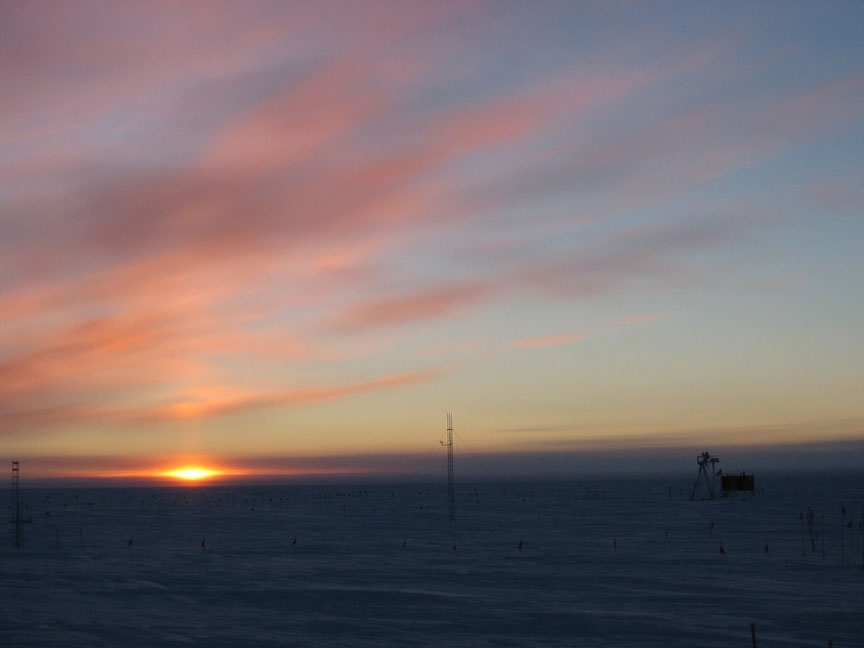
The silhouette of the SETI telescope tower is seen to the right as the sun sets at the South Pole for six months

The
silhouette of the SETI telescope tower is seen to the right as the sun
sets at the
South Pole for six months
March at the Pole - the sun
sets for
6 months
The
weather was very windy with blowing snow and poor visibility from
about the last flight on February 15th until about March 19th.
Temperatures have almost reached -90 F already. Drifting was heavy and
I spend much time digging out the back door of the Cusp lab on the
first floor of skylab and the entrance to the VLF beacon transmitter
building about a mile out in the dark sector. back
door of the cusp lab after digging out snow
drifted door to the VLF transmitter building
ARO
seen through the wind-blown snow SETI telescope tower and
AASTO building dome and elevated station from
the dark sector
The
whole station is now criss-crossed with flags lines so that we can find
our way to our destinations, some over a mile away, when darkness and
whiteout conditions prevail. flagline from ARO to the
SETI telescope flagline from the dark
sector to the dome flagline crossing the skiway
Now
that the temperatures are dropping and will eventually drop below -100
F
most motorized vehicles are unavailable. Walking is the way to get
around and although it it beautiful and fantastic to walk outside in
the darkness, it will get very frequently extremely difficult to walk a
mile or so in temperatures near -100 F, with high winds and on a
sastrugi covered surface while your goggles are completely frosted
over. That is the challenge. If you want to carry something to
your destination you can man haul a sled. frosted face
after a one mile walk back from the VLF beacon transmitter building hauling a sled back from
the dark sector
The
atmosphere at the South Pole has an extremely strong inversion layer,
particularly in the winter. In a typical air mass the temperature of
the
air drops somewhere around 5 degrees F for every 1000 feet of
elevation, but at the Pole the temperature in the winter is actually
warmer
as you rise in elevation. This creates some unusual phenomena.
For example, when warm exhaust exits our power plant stack it rises
just for a moment and then it immediately drops to the ice surface and
hugs the surface for miles. power plant exhaust
exhaust dropping
to the ice surface power plant exhaust
seen from dark sector
After
seeing the sun rotate around us for the past 6 months, it finally set
March 21. We will not see the sun again for 6 months. The good part is
that we will enjoy a constant light show of the stars that are visible
from the
Southern Hemisphere , we will view the auroras that will appear daily,
we will experience the
periodic passing of sun illuminated satellites and we will see the moon
for two weeks each month, all of this weather permitting, of
course.
the dome and skylab several
days before sunset sun setting through
the power plant exhaust
The
sunset was not as spectacular as it could have been due to the stubborn
presence of clouds and ice fog from horizon to about 5 to 10 degrees
above the horizon. There were, however, several short windows of
opportunity to see some beautiful colors and the horizon did clear
several days after sunset. sun behind the station on
March 18 pink skies behind the dome and
elevated station silhouette of the station
sunset
over ARO
 Panorama looking grid north at the fuel
arch escape igloo, the Atmospheric Research Observatory (ARO) and the
SETI telescope (scroll to the right to see the entire view)
Panorama looking grid north at the fuel
arch escape igloo, the Atmospheric Research Observatory (ARO) and the
SETI telescope (scroll to the right to see the entire view)
I took a few photos of my room in upper berthing. It is small but
comfortable. I have a small desk for my laptop, shelves, a small
bed and in the back you can see the freezer door to the outside. I also
have a flat panel monitor over my bed hooked to the laptop so I can
watch DVD movies. my room
my room
my room without camera flash
inside the dome, upper
berthing on the right outside of upper berthing
showing freezer doors of each room
One final photograph showing that there is still plenty of light 9 days
after sunset. It will get gradually darker over the next two weeks
until it finally gets completely dark by mid
April. station on March 30
NEXT MONTH: The
appearance of stars, auroras, and satellites
A Real-Time Photo of South Pole Station as Seen from the ARO Building (live when satellite is up)
A Comprehensive
South Pole Web Site by Bill Spindler
Winterover Web Pages
(Bill Spindler's List)
SOUTH
POLE 2003-2004 HOME PAGE